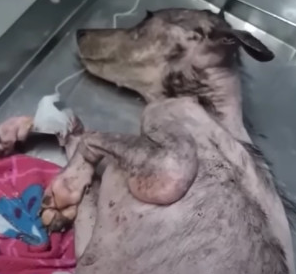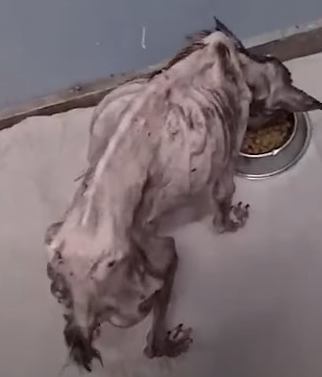Angela’s story is one that tugs at the heartstrings and challenges us to confront the reality of what neglect truly looks like. For nearly ten years, this gentle dog knew nothing but the walls of a small, cold cage. There was no warmth, no love, no moments of freedom or joy. Her days blended into nights, and the seasons changed around her while she remained trapped in silence. Angela had no shelter beyond that wire prison, no medical attention, no companionship—just isolation and despair.
Her existence might have continued unnoticed if not for a sudden change in fate. When the property where she had been confined was sold, someone finally stumbled upon her. What they discovered was nothing short of devastating. Angela was lying in her own filth, her body wasted and fragile, completely covered in wounds. Her skin was raw from years of lying on hard, dirty surfaces. Her fur was tangled and matted, filled with feces and dirt. But what hit the hardest was her expression—empty, tired, and barely clinging to life. There was no energy left in her body to resist or react. She was simply waiting for it all to end.
Rescuers moved quickly. Angela was carefully lifted out of the cage that had defined her life for nearly a decade and rushed to an animal hospital. Her condition was critical. Her frail body, weighed down by years of malnourishment, barely registered any strength. She was too weak to stand. Every bone showed through her thin coat. She was dehydrated and her internal organs were showing signs of distress. Just looking at her, the team knew that her survival would be nothing short of a miracle.
The first step was to clean her. Angela’s fur was so badly matted and coated in waste that it took hours of careful work to remove it without causing her further pain. As the dirt was gently washed away, her skin revealed the toll of years of abuse—scars, sores, and infections that had never been treated. The medical team gave her small, frequent meals specially formulated for dogs with liver conditions, as her body couldn’t handle too much food at once. It was a delicate balance—nourish her without overwhelming her weakened system.

Despite the years of suffering, Angela showed something extraordinary: a will to live. Her eyes, once dull, began to reflect the flicker of hope. She accepted the care without fear. She began to eat. She rested. She let the team touch her, treat her, love her. Slowly, she started to regain a little strength each day. It was as though, after being forgotten for so long, she finally felt safe enough to begin healing.
After a week of intensive care and stabilization, Angela was ready for the next challenge—a major surgery. She had developed a severe uterine infection, likely caused by years of neglect and lack of basic hygiene. The condition was life-threatening and required immediate intervention. The surgery was risky, given her fragile condition, but it was her only shot at survival. The veterinary team prepared carefully, knowing how much was at stake.
Angela made it through the operation. The moment she opened her eyes afterward was filled with cautious celebration. She had fought her way through another impossible obstacle. Within days, she stood on her own. She began to walk, slowly at first, then more confidently. Her tail wagged—a small motion, but filled with meaning. The transformation was subtle but powerful. The dog who had once been written off as a lost cause was now showing signs of life, resilience, and even joy.
Her recovery didn’t stop there. Each passing day brought new progress. Angela’s appetite improved. Her wounds began to heal. Her coat grew softer. But most of all, her spirit started to return. She became more alert, more responsive. She looked people in the eyes. She sought out touch and affection. It was as if she was learning, for the first time, what it meant to be a dog—to trust, to hope, to connect.
Angela’s journey serves as a powerful reminder of what compassion can do. She was given up on for nearly a decade, yet when offered even the smallest amount of care, she began to thrive. Her story underscores the importance of never turning a blind eye to suffering, and of believing in second chances. The world had forgotten her, but kindness brought her back.

There are countless animals like Angela—hidden behind fences, locked away in cages, enduring unimaginable pain in silence. Her story is not just about rescue; it’s about recognition. Recognizing the lives that are still worth saving, even when they seem beyond hope. It’s about the quiet strength that exists in the most broken of beings, waiting for someone to see them.
Today, Angela is no longer the dog in the cage. She is safe, surrounded by people who care deeply about her well-being. She has soft blankets, warm meals, and gentle hands to guide her forward. Most importantly, she has love—something she had been denied for most of her life. She now sleeps peacefully, dreams quietly, and greets each day with new curiosity. Her past will always be part of her story, but it no longer defines her.
Angela’s transformation didn’t happen overnight. It took patience, effort, and a deep belief that she deserved a better life. And now, because of that belief, she has one. She went from being forgotten and discarded to being cherished and protected. Her resilience is awe-inspiring, and her ability to trust again is a testament to the healing power of care and compassion.
In the end, Angela’s story is more than a rescue tale—it’s a symbol of hope. It shows us that even in the darkest circumstances, the spark of life can still burn. It reminds us to never give up on those who seem broken. Because with love, time, and care, even the most fragile lives can grow strong again. Angela didn’t just survive—she began to live. And that makes all the difference.
